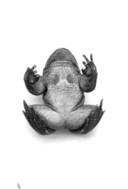|
Chrysopaa sternosignata (Murray, 1885)
Karez frog | family: Dicroglossidae subfamily: Dicroglossinae genus: Chrysopaa |
| Species Description: Ohler, Dubois 2006 Zoosystema 28 revalidated the 1885 species of Murray. | |
 © 1995 Muhammad Sharif Khan (1 of 2) |
|
|
|
Description Coloration: Adults are olive brown or dark green above, with small irregular yellow, orange, or reddish spots; ventrum white with profuse fine dark brown or black mottling. Juveniles dark brown or olive, with blackish blotches. Pupil reduced to a narrow slit. A transverse dark streak runs across the eye, a similar vertical streak runs downward across the goldenbrown iris, giving the eye a peculiar appearance. This feature is also present in tadpoles (Khan 1986). The body of the tadpole is elongated, bulging, eyes are anterodorsal, tail very muscular, with broad dorsal and narrower ventral fins, acutely pointed tip. The anteroventral oral disc is surprisingly small for this heavy and broad-bodied large tadpole. Fringe of oral papillae does not extend along anterior labium, however it is entire along posterior labium. Beak narrow, finely serrated, labial tooth row formula is 5(4)/3. Total length of the tadpole 78-80 mm, tail 50-52 mm (Khan 1986). Distribution and Habitat Country distribution from AmphibiaWeb's database: Afghanistan, India, Pakistan
Life History, Abundance, Activity, and Special Behaviors Reproductive activity is at its peak from April to June. Males call from the margin of flowing water at sunset. The call is a low-pitched melodious "Taroon, taroon, taroon" uttered three to four times rapidly. One has to wait for 5-10 minutes to hear the next outburst of calls. Calling males are solitary. Eggs are large (2.6-3.0 mm) and laid in groups enclosed in jelly coats, which soon are attached to the submerged vegetation. Abortive interspecific amplectic pairing is common between Chrysopaa sternosignata and Euphlyctis cyanophlyctis (Khan and Ahmed 1987). The tadpole is the largest and stoutest of all Pakistani tadpoles. It coexists with tadpoles of Euphlyctis cyanophlyctis and Bufo viridis in karez water, later mostly confined to side pools. The tadpole feeds on algal vegetation amply available in the karez channel (Khan 1986). The frog feeds on insects, crabs, small fishes, dragonflies, and a host of other water-visiting arthropods (Khan 1986).
References
Khan, M. S. (2006). Amphibians and Reptiles of Pakistan. Krieger Publishing Co., Malabar, FL. Khan, M.S. (1987). ''Checklist, distribution and zoogeographical affinities of amphibians and reptiles of Balochistan.'' Proceedings of the7th Pakistan Congress of Zoology, 1987, 105-112. Khan, M.S. and Ahmed, N. (1987). ''On a collection of amphibians and reptiles from Baluchistan, Pakistan.'' Pakistan Journal of Zoology, 19, 361-370. Kullmann, E. (1974). ''Die Tierwelt Ostafghanistans in ihren geographischen Beziehungen.'' Freunde des Kölner Zoo, 13, 13-25. Murray, J. A. (1855). ''A new frog (Rana sternosignata) from Sind.'' Annals and Magazine of Natural History, Series 5, 16, 120-121. Originally submitted by: M. S. Khan (first posted 2010-02-25) Edited by: Kellie Whittaker (2010-04-08) Species Account Citation: AmphibiaWeb 2010 Chrysopaa sternosignata: Karez frog <https://amphibiaweb.org/species/7445> University of California, Berkeley, CA, USA. Accessed Nov 18, 2024.
Feedback or comments about this page.
Citation: AmphibiaWeb. 2024. <https://amphibiaweb.org> University of California, Berkeley, CA, USA. Accessed 18 Nov 2024. AmphibiaWeb's policy on data use. |


 Map of Life
Map of Life